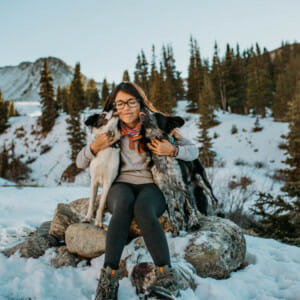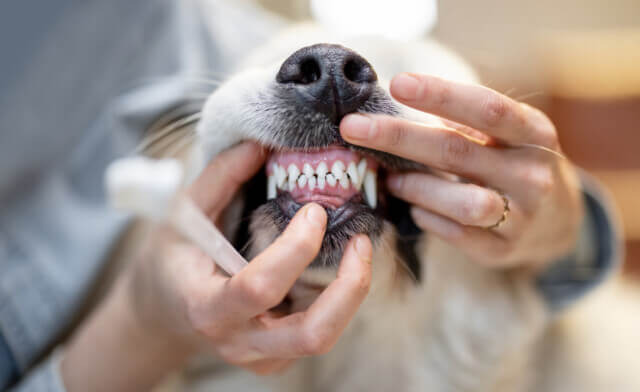First Aid for Dogs
With every adventure comes great responsibilities. We all love going outdoors with our four-legged friends. This means being prepared for any mishaps that we might find ourselves in. I’m sure it’s happened to all of us. You’re out on the trail and your pup just stepped on a cactus or perhaps just ate a bee! What do you do now? Or perhaps you’re thinking about going outside with your best friend but you don’t know what to do or what to carry in case of emergencies. I’m here to give you a little tutorial about making a first aid kit for you and your dog and how to handle some of the most common injuries that can happen on the trail.
If you are concerned for your pet’s health please reach out to your local veterinarian.

First Aid Kit
The first question you might ask yourself is what to bring along for you and your dog? There are some really good premade first aid kits for dogs that you can purchase or you can make one! Here are the must have supplies that you should carry anytime you are out adventuring with your pup or even just to have at home in case of an emergency.
As seen below you will need bandage material: padding, rolled gauze, vet wrap or equivalent, non-adherent pad, tape; triple-antibiotic ointment, cleaning solution (I like saline and betadine), Benadryl, human bandages, human-only medications, tweezers, quick stop, and lastly an ophthalmic saline wash. All these supplies can also be used on yourself, too, so it’s a win-win. I would recommend putting all these supplies in a waterproof pouch such as a ziplock baggie.

Basic Triage
It is important for every dog owner to know basic triage. This consists of taking and understanding basic life vital signs. This is usually referred to as a TPR: Temperature, Pulse/Heart rate, Respiratory rate and mucous membrane color.
Taking a dog‘s temperature is typically done rectally and usually not something that most dogs will let you do willingly. However it is important to note that dogs have a much higher body temperature than humans. A normal temperature can range from 100.0 to 102.5.
A dog’s heart rate can vary depending on breed, size, and athletic ability. For example, a 10-pound Chihuahua will have a higher heart rate than a 180-pound Great Dane. Athletic dogs will typically have a slower heart rate than their counterparts and this is considered normal for them. There are a few ways you can check your dog’s heart rate. The easiest way is to place your palm on the left side of their chest at elbow height. However, you may not feel the heartbeat if the dog is muscular or overweight. In this case, you can locate the femoral artery. This is done by placing your fingers inside the inguinal area of either of your dog’s hind legs. Press down gently and move your fingers until you can find the pulse. Don’t use your thumb to palpate otherwise you will be counting your own heartbeat! Lastly, if you have a stethoscope you can ascult the left lower portion of the chest. Once you have located a pulse, count for 15 seconds and multiply that by 4. For example: 20 x 4 = 100 beats per minute. This same method is used to count breaths per minute. Any abnormal breathing should be evaluated by a veterinary professional and can be life threatening.
Lastly, a dog’s mucous membrane or gum color should always be a nice bubble gum pink. Any discoloration that is not pigmentation such as grey, white, yellow or blue should be evaluated by a veterinarian.

Torn Nails or Pads
One of the most common things that can happen on the trail are torn nails or a torn paw pad. It happens most often during the hot summer months where the ground is much hotter and can cause more irritation to paw pads. If your dog has torn a toenail first we must assess if the nail needs to be removed or if it has come off already. If the toenail is still attached the likelihood that your dog will let you remove the toenail is unlikely. This can be very painful and you’ll need to seek medical attention.
If the toenail has come off and the quick is exposed then it is manageable without seeking medical attention. You will need to clean the nail with an antiseptic. If the nail is bleeding you can apply Kwik-Stop and slight pressure until the bleeding has stopped. At this time place a small bandage on the foot for the next 2 to 3 days. A boot or some type of foot covering will need to be used until the toenail has started to grow back to keep it clean and protected. Do not let your dog lick or eat the bandage. Excessive licking of the toenail will cause infection.
A torn paw pad is treated very similarly. If any excessive pad is hanging off it’s important to remove it. This will allow new pad tissue to grow. Apply triple antibiotic ointment and place a bandage. You can change the bandage daily or as needed. Administering Epsom salt foot soaks for about five minutes three times a day can help promote healing. Paw pads take a lot longer to heal and a boot will need to be worn for several weeks or until healed. If at any point there is concern for pain, limping, or infection you should visit your veterinarian.
Lacerations
The worst has happened. You were out on the trail and your dog has stepped on something and has just lacerated his paw pad. There’s blood everywhere and you don’t know what to do. First, calm down–it’s going to be okay. Take out your first aid kit and let’s place a temporary bandage. This will allow pressure on the wound to help stop the bleeding and keep the wound as clean as possible. Make sure to add a non-adherent pad to the wound before you begin wrapping it with your padding. This will keep anything from being stuck into the wound and be easier to remove later. Bandage the foot as best you can using your padding, then roll gauze, and lastly your vet wrap or an equivalent.
If you are using tourniquet due to excessive bleeding it should not be left on for more than 15 minutes at a time. A tourniquet left on can cause serious nerve damage. Never use tape or duct tape to cover a bandage or to keep a bandage on as it can cause a tourniquet affect. At this time you can transport your dog to the closest emergency hospital.
Not all lacerations happen on a foot. Sometimes they might be on the side of the chest, on the back or on the face. If the wound is bleeding use a cloth to apply pressure if your dog allows it. Otherwise do not attempt to clean the wound and seek medical attention.

Allergic Reactions
Dogs love to chase flying critters like bees and wasps. After eating or being stung by some type of insect they come back with a puffy face and hives. This is what we call an allergic reaction. For mild allergic reactions you can give Benadryl by mouth and see if the allergic reaction resolves. You need to give 1 mg per pound of body weight to be effective. If giving Benadryl at home does not resolve the facial swelling and hives, a trip to the ER is necessary. Some dogs will not show these typical signs but instead will develop an anaphylactic reaction. Typical signs of this are collapsing immediately after being stung/bite, vomiting, diarrhea, pale/white gums, and increased heart rate. If any of these symptoms arise seek medical attention immediately.
Animal Encounters
Encountering other animals on a trail or out camping is inevitable. Unfortunately, not all animal encounters end up with being the best of friends. Not all dogs like other dogs and fights may happen. If your dog is bitten or attacked, once the commotion dies down, inspect your dog for wounds. You can treat minor scratches by cleaning them with an antiseptic from your first aid kit. Any deep wounds or lacerations should be properly addressed by a veterinarian to avoid infection.
Stay Calm
Even though there are many things that can go wrong while adventuring with your dog, don’t let that stop you from experiencing all that the great outdoors has to offer! With a little prep and planning you’ll be plenty prepared to handle small emergencies should they arise. And if they do, stay calm and pay your vet a visit with any concerns.




